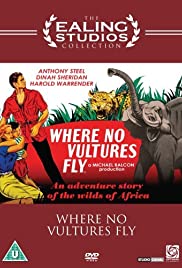Where No Vultures Fly [Ivory Hunter] *** (1951, Anthony Steel, Dinah Sheridan, Harold Warrender) – Classic Movie Review 9798

Anthony Steel and Dinah Sheridan star effectively as the East African national park game warden and his wife, in the sharp and swift Ealing Studios realist-style 1951 jungle adventure film Where No Vultures Fly.
Director Harry Watt’s 1951 Where No Vultures Fly [Ivory Hunter] is based on Watt’s own story, with a screenplay by W P Lipscomb, Ralph Smart and Leslie Norman. The title denotes areas where there are no dead animals.
Anthony Steel and Dinah Sheridan star effectively as Bob Payton, the East African national park game warden of Mount Kilimanjaro Game Reserve, and his wife Mary Payton, in this sharp and swift-as-an-arrow, brisk, realist-style Ealing Studios jungle adventure film.
Though the yarn is on the undynamic an uneventful side for this running time, the attractive Technicolor location filming, the wild animals and eye-catching nature scenes easily compensate. The rhino attack of a truck is especially excitingly captured.
The year’s Royal Command Performance film, this is quite an effective, if thoroughly old-fashioned film, which was a popular hit and prompted a sequel, West of Zanzibar, in 1954.
In the sequel, Sheila Sim inherited Sheridan’s part when the star married studio boss John Davis and retired, and Paul Beeson was promoted to main director of photography having just done the wildlife photography this time.
Also in the cast are William Simons as Tim Payton, Harold Warrender, Meredith Edwards, Orlando Martins, Andrew Cruickshank and Phillip Birkinshaw.
It is inspired by the work of the conservationist Mervyn Cowie, though the opening credits say: ‘The characters in this film are imaginary, but the story is based on the recent struggle of Mervyn Cowie to form the National Parks of Kenya.’ Harry Watt tracked down Cowie in Nairobi.
W P Lipscomb wrote the script based on Harry Watt’s story idea, then Ralph Smart worked on it, and then Leslie Norman did. He recalled: ‘The script was turned down generally, so I went in and added a bit which made them accept it.’
Where No Vultures Fly [Ivory Hunter] is directed by Harry Watt, runs 107 minutes, is made by Ealing Studios, is written by W P Lipscomb, Ralph Smart and Leslie Norman, based on Harry Watt’s story, is shot in Technicolor by Geoffrey Unsworth and Paul Beeson, is produced by Michael Balcon and Leslie Norman, and is scored by Alan Rawsthorne.
It is a 50/50 co-production between Ealing and African Films, a South African theatre chain.
Harry Watt took a full unit to Africa and based it at Amboseli, south of Nairobi, at the end of November 1950 for a four-month shoot, building a village of huts where the crew could live. Anthony Steel contracted malaria in Kenya.
It was the second most popular film at the British box office in 1952 and fairly popular in the US, too, where it took $800,000, released under the title Ivory Hunter.
William Simons (1940-2019) played curmudgeonly PC Alf Ventress in all 18 seasons of TV’s Heartbeat (1992-2009) – 355 episodes.
The cast are Anthony Steel as Bob Payton, Dinah Sheridan as Mary Payton, Harold Warrender as Mannering, Meredith Edwards as Gwyl, William Simons as Tim Payton, Orlando Martins as M’Kwongi, Andrew Cruickshank and Phillip Birkinshaw.
© Derek Winnert 2020 Classic Movie Review 9798
Check out more reviews on http://derekwinnert.com


